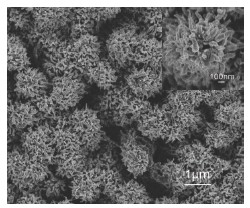| [1] Zhang, Q.-B.; Feng, Z.-F.; Han, N.-N.; Lin, L.-L.; Zhou, J.-Z.; Lin, Z.-H. Acta Phys.-Chim. Sin. 2010, 26, 2927. (张桥保, 冯增芳, 韩楠楠, 林玲玲, 周剑章, 林仲华, 物理化学学报, 2010, 26, 2927.)[2] Vanalakar, S. A.; Pawar, R. C.; Suryawanshi, M. P.; Mali, S. S.; Dalavi, D. S.; Moholkar, A. V.; Sim, K. U.; Kown, Y. B.; Kim, J. H.; Patil, P. S. Mater. Lett. 2011, 65, 548. [3] Mali, S. S.; Devanb, R. S.; Ma, Y.-R.; Betty, C. A.; Bhosale, P. N.; Panmand, R. P.; Kale, B. B.; Jadkar, S. R.; Patil, P. S.; Kim, J.-H.; Hong, C. K. Electrochim. Acta 2013, 90, 666. [4] Gao, J.-B.; Luther, J. M.; Semonin, O. E.; Ellingson, R. J.; Nozik, A. J.; Beard, M. C. Nano Lett. 2011, 11, 1002. [5] Hao, Y.-Z.; Wang, W. Acta Chim. Sinica 2007, 65, 489. (郝彦忠, 王伟, 化学学报, 2007, 65, 489.)[6] Leschkies, K. S.; Divakar, R.; Basu, J.; Enache-Pommer, E.; Boercker, J. E.; Carter, C. B.; Kortshagen, U. R.; Norris, D. J.; Aydil, E. S. Nano Lett. 2007, 7, 1793. [7] Han, Z.-Z.; Wei, L.-Y.; Tang, L.-L.; Chen, C.-Q.; Pan, H.-B.; Chen, J.-Z. J. Power Sources 2013, 239, 546. [8] Lan, G.-Y.; Yang, Z.; Lin, Y.-W.; Lin, Z.-H.; Liao, H.-Y.; Chang, H.-T. J. Mater. Chem. 2009, 19, 2349. [9] Yu, P.-R.; Zhu, K.; Norman, A. G.; Ferrere, S.; Frank, A. J.; Nozik, A. J. Phys. Chem. B 2006, 110, 25451. [10] Baker, D. R.; Kamat, P. V. Adv. Funct. Mater. 2009, 19, 805. [11] Vanalakar, S. A.; Mali, S. S.; Pawar, R. C.; Tarwal, N. L.; Moholkar, A. V.; Kim, J. H.; Patil, P. S. J. Appl. Phys. 2012, 112, 044302. [12] Wang, H.; Bai, Y.-S.; Zhang, H.; Zhang, Z.-H.; Li, J.-H.; Guo, L. J. Phys. Chem. C 2010, 114, 16451. [13] Kamat, P. V. J. Phys. Chem. C 2008, 112, 18737. [14] Plass, R.; Pelet, S.; Krueger, J.; Grätzel, M. J. Phys. Chem. B 2002, 106, 7578. [15] Hao, Y.-Z.; Ma, J.-X.; Sun, B.; Li, Y.-P.; Ren, J.-J. Acta Chim. Sinica 2010, 68, 33. (郝彦忠, 马洁霞, 孙宝, 李英品, 任聚杰, 化学学报, 2010, 68, 33.)[16] Sun, B.; Hao, Y.-Z.; Guo, F.; Cao, Y.-H.; Zhang, Y.-H.; Li, Y.-P.; Xu, D.-S. J. Phys. Chem. C 2012, 116, 1395. [17] Hao, Y.-Z.; Cao, Y.-H.; Sun, B.; Li, Y.-P.; Zhang, Y.-H.; Xu, D.-S. Sol. Energy Mater. Sol. Cells 2012, 101, 107. [18] Li, Y.-P.; Hao, Y.-Z.; Sun, S.; Sun, B.; Pei, J.; Zhang, Y.-H.; Xu, D.-S.; Liu, L. RSC Adv. 2013, 3, 1541. [19] Wright, M.; Uddin, A. Sol. Energy Mater. Sol. Cells 2012, 107, 87. [20] Xu, T.-T.; Venkatesan, S.; Galipeau, D.; Qiao, Q.-Q. Sol. Energy Mater. Sol. Cells 2013, 108, 246. [21] Gur, I.; Fromer, N. A.; Chen, C.-P.; Kanaras, A. G.; Alivisatos, A. P. Nano Lett. 2007, 7, 409. [22] Huynh, W. U.; Dittmer, J. J.; Alivisatos, A. P. Science 2002, 295, 2425. [23] Hao, Y.-Z.; Luo, C.; Sun, B.; Sun, S.; Li, Y.-P.; Shen, S.-G.; Xu, D.-S. Sci. China Chem. 2013, 56, 755. [24] Sun, B.; Hao, Y.-Z.; Guo, F.; Li, Y.-P.; Luo, C.; Pei, J.; Shen, S.-G. Acta Phys.-Chim. Sin. 2012, 28, 2861. (孙宝, 郝彦忠, 郭奋, 李英品, 罗冲, 裴娟, 申世刚, 物理化学学报, 2012, 28, 2861.)[25] Hao, Y.-Z.; Cao, Y.-H.; Sun, B.; Zhang, Y.-H.; Li, Y.-P.; Xu, D.-S.; Li, X.-L. Acta Chim. Sinica 2012, 70, 1139. (郝彦忠, 曹寅虎, 孙宝, 张彦辉, 李英品, 徐东升, 李香玲, 化学学报, 2012, 70, 1139.)[26] Xiang, H.-J.; Wei, S.-H.; Gong, X.-G. J. Phys. Chem. C 2009, 113, 18968. |
